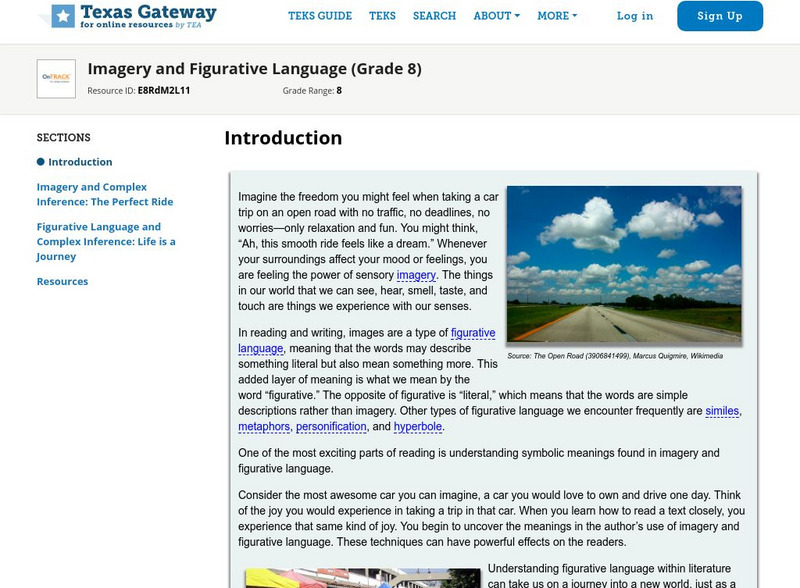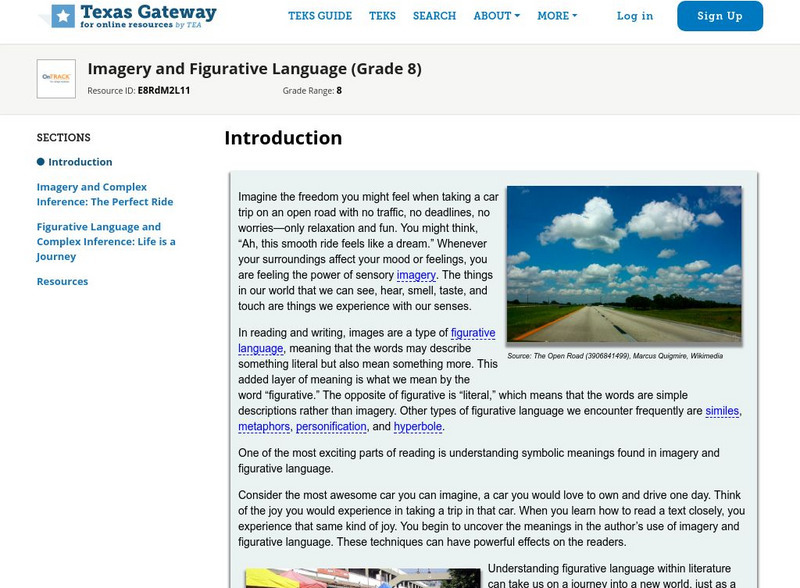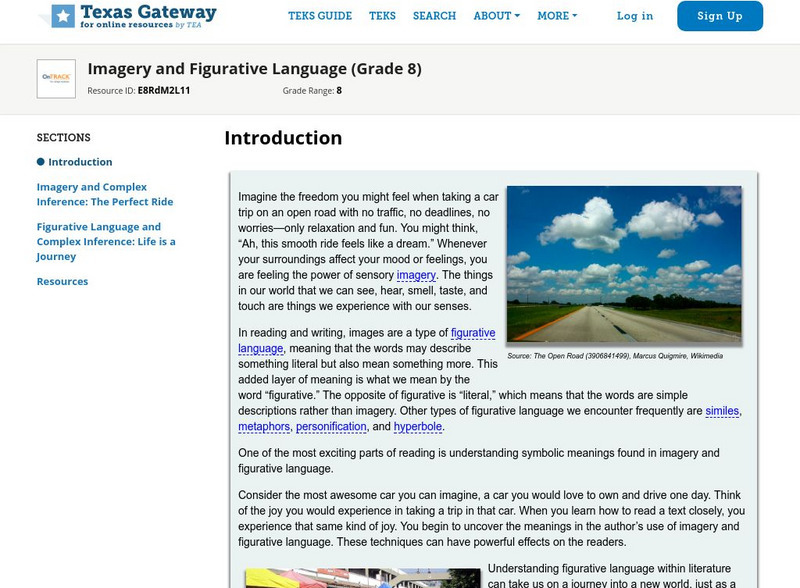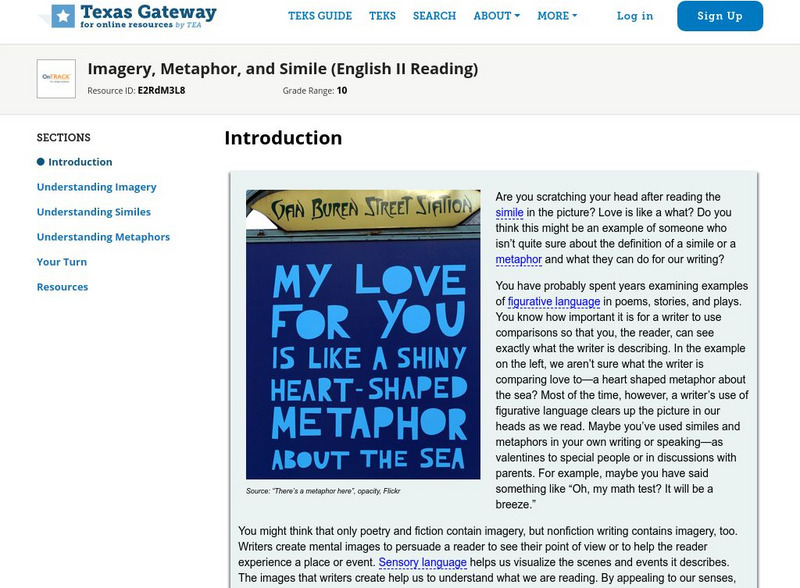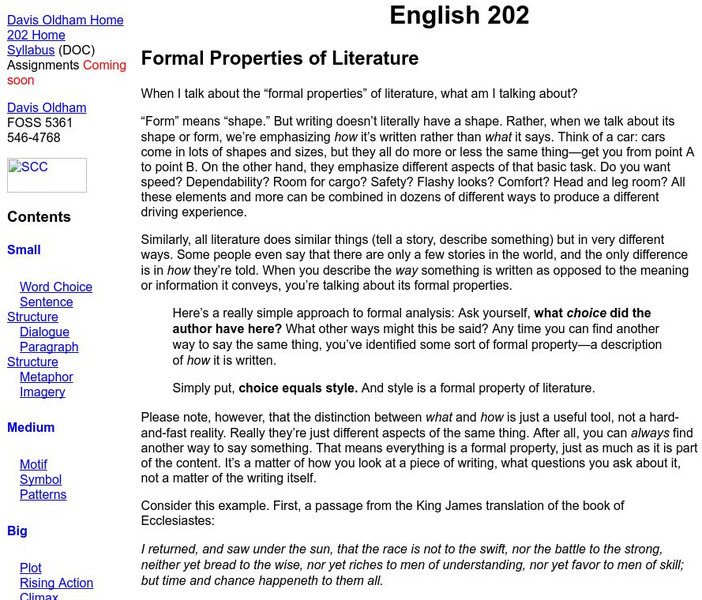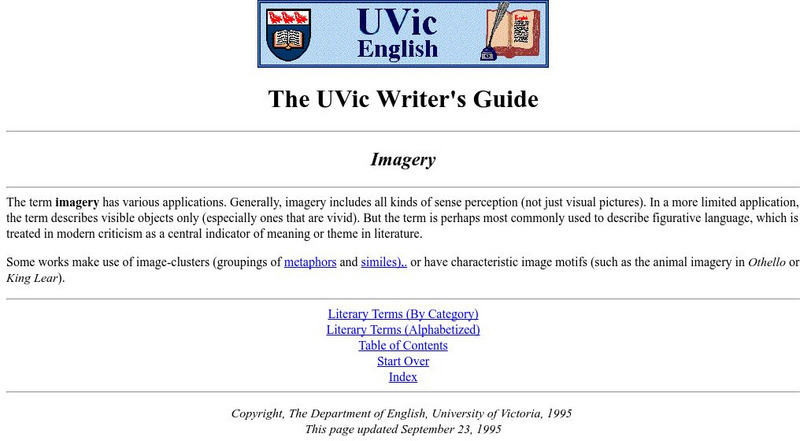Curated OER
Poetry
Students apply reading comprehension skills to poetry and synthesize the information to create a new piece of work.
Curated OER
Those Cells Look Good Enough to Eat
Students explore the parts of the cell. In this cell lesson, students use foods to create cell models that represent the nucleus, cytoplasm, cell membrane, mitochondria, ribosomes, vacuoles, endoplasmic reticulum, and Golgi bodies...
Curated OER
Changes in Latitudes, Changes in Attitudes
Sixth graders discuss how people, society, and technology change over time through a unit of integrated lessons. In these changes in society lessons, 6th graders discuss the answers to many questions about how changes effect the...
Curated OER
Harrisification
Students use the internet to research Robert Harris' life and art work. Using this information, they write a journal entry from his point of view and share it with the class. They also paint a picture from a scene of their own life...
Texas Education Agency
Texas Gateway: Imagery and Figurative Language (Grade 6)
This lesson focuses on the use of imagery and figurative language in writing to aid understanding and create images in the mind.
Texas Education Agency
Texas Gateway: Imagery and Figurative Language (English 7 Reading)
This lesson, focuses on three ways to use figurative language: to create imagery, to appeal to the senses (using sensory detail), and to suggest mood.
Texas Education Agency
Texas Gateway: Imagery and Figurative Language (Grade 8)
In this lesson, students learn how to make complex inferences and use textual evidence such as imagery and figurative language to support understanding.
Texas Education Agency
Texas Gateway: Imagery and Figurative Language
In this lesson, you will learn how to make complex inferences and use textual evidence such as imagery and figurative language to support understanding.
Texas Education Agency
Texas Gateway: Imagery and Figurative Language (Grade 8)
Make complex inferences and use textual evidence such as imagery and figurative language to support understanding.
Louisiana Department of Education
Louisiana Doe: Louisiana Believes: English Language Arts: Grade 9: Romeo and Juliet
Students explore how patterns and contrasts in language (diction, imagery, figurative language) reveal central ideas in texts and develop various motifs (light vs. dark, dreams vs. reality, high vs. low, etc.) in Romeo and Juliet. They...
Folger Shakespeare Library
Folger Shakespeare Library: Lesson Plan Archive: Imagery in Hamlet
Lesson plan takes students through an exploration of the figurative language in "Hamlet."
Texas Education Agency
Texas Gateway: Literary Text: Imagery, Metaphor, and Simile
Writers use sensory imagery ("smelled the salty air"), similes ("like a strong man playing tug-of-war"), and metaphors ("the waves roaring in my ears") to capture the reader's imagination. In this lesson, you will learn how to identify...
Georgia Department of Education
Ga Virtual Learning: Ap Literature & Composition: Appearance vs. Reality
This is an introduction to the literary theme of appearance vs. reality using Hamlet, a tragedy by William Shakespeare. It features a list of key terms including literary devices and dramatic terms; essential questions including how the...
Georgia Department of Education
Ga Virtual Learning: Contemporary Literature: The Modern Poet
This is an introduction to a modern poetry unit; it features links to poetry and technology standards and a list of key terms. The essential questions for the unit focuses on the characteristics of contemporary poetry, how poets use...
National Endowment for the Humanities
Neh: Edsit Ement: Poems of Tennyson and Noyes: Pictures in Words
This is a great and informative site. This instructional activity uses Tennyson's "The Charge of the Light Brigade" and Noyes's "The Highwayman" to teach vivid imagery and figurative language. Don't miss out.
PBS
Pbs Learning Media: Elements of Poetry
Discover how literary techniques like figurative language, imagery, and symbolism contribute to the overall meaning of a poem. Explore how a poet establishes and builds on a theme and the difference between tone and mood. Through a close...
Department of Defense
Do Dea: Music From the Ashes
This is a self-guided learning unit on the topic of poetry. Included are lessons, self-assessments, background information, learning activities, and related literature. Learn how to analyze poetry, appreciate figurative language, and...
Texas Education Agency
Texas Gateway: Imagery: Simile and Metaphor (English I Reading)
[Accessible by TX Educators. Free Registration/Login Required] Identify the similes and metaphors in a text and evaluate their importance to the meaning of the text. RL.9-10.5 text structure effects
Love To Know Media
Your Dictionary: Literary Terms Lesson Plan
This is a lesson plan for teaching the seven literary terms used in poetry: simile, metaphor, alliteration, imagery, hyperbole, personification, and onomatopoeia.
Texas Education Agency
Texas Gateway: Literary Text: Close Reading of Poetry: Practice 3
This lesson will help you comprehend the poet's meaning by giving you practice in finding imagery, metaphors, symbolism, and allusions.
Other
Shoreline Community College: Formal Properties of Literature
As students become more aware of text complexity, an understanding of the formal properties of literature becomes more important. This is an excellent examination of the kinds of choices writers make that change the way readers receive...
PBS
Pbs Learning Media: Literary Elements and Techniques Collection
These animated shorts introduce or review literary elements and techniques like theme, setting, figurative language, characterization, and conflict. They can be used when students are just learning how to identify the most commonly used...
University of Victoria (Canada)
The U Vic Writer's Guide: Literary Term: Imagery
This site from The UVic Writer's Guide provides a brief description of the literary term "imagery."
TES Global
Blendspace: 3rd Grade Poetry Investigation
A learning module with thirty-one links to texts, videos, images, websites, and slides on different types and forms of poetry as well as poetic imagery, rhyme, figurative language use, and more.








